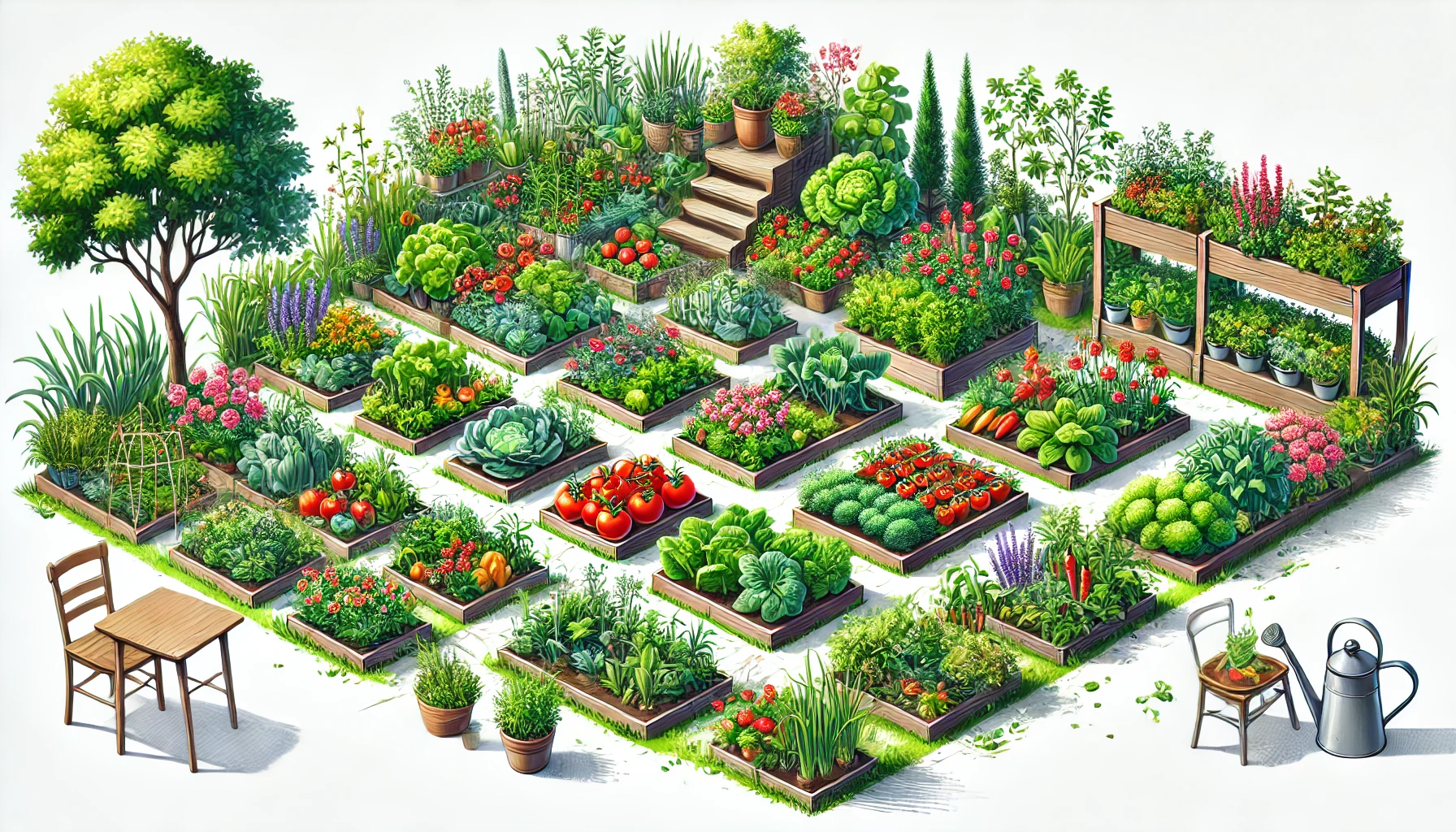Growing your own fruits and vegetables is a rewarding experience that not only saves you money but also ensures a fresh and healthy food supply. An edible garden can be both functional and beautiful, providing nutritious produce while enhancing your outdoor space. Whether you have a spacious backyard or a small balcony, you can cultivate a thriving edible garden. In this article, we’ll explore the best plants to grow, essential gardening tips, and creative ideas to maximize your space and harvest.
Why Start an Edible Garden?
1. Fresh and Healthy Food
Homegrown fruits and vegetables are fresher and more nutritious than store-bought produce, as they are harvested at peak ripeness.
2. Cost-Effective
Growing your own food reduces grocery bills and allows you to enjoy organic produce at a fraction of the cost.
3. Environmental Impact
By growing locally, you reduce your carbon footprint by eliminating the need for transportation and plastic packaging.
4. Educational Experience
Gardening is an educational and fun activity for the whole family, teaching children about nature, sustainability, and healthy eating.
5. Therapeutic and Fun
Gardening is known to reduce stress and improve mental well-being, making it a relaxing and enjoyable hobby.
Best Fruits and Vegetables for an Edible Garden
Choosing the right plants is essential for a productive garden. Here are some easy-to-grow options suitable for beginners:
1. Tomatoes
- Varieties: Cherry, Roma, Beefsteak.
- Growing Tips:
- Plant in full sun (6-8 hours of direct sunlight).
- Use well-draining soil rich in organic matter.
- Water consistently and evenly to prevent cracking.
- Support with stakes or cages for better growth.
- Why Grow It: High yield and versatile for cooking.
2. Leafy Greens
- Types: Lettuce, Spinach, Kale, Swiss Chard.
- Growing Tips:
- Prefer partial shade, especially in hot climates.
- Harvest leaves regularly to encourage continuous growth.
- Keep soil consistently moist.
- Why Grow It: Fast-growing and nutritious.
3. Peppers
- Varieties: Bell Peppers, Jalapeños, Habaneros.
- Growing Tips:
- Need full sun and warm temperatures.
- Avoid over-watering to prevent root rot.
- Use well-draining, nutrient-rich soil.
- Why Grow It: Compact plants ideal for containers.
4. Strawberries
- Varieties: June-bearing, Ever-bearing, Day-neutral.
- Growing Tips:
- Plant in full sun for sweet, juicy berries.
- Mulch around plants to retain moisture and prevent weeds.
- Fertilize with compost or balanced fertilizer.
- Why Grow It: Delicious and perfect for small spaces or hanging baskets.
5. Herbs
- Types: Basil, Mint, Rosemary, Thyme, Parsley.
- Growing Tips:
- Most herbs need full sun (at least 6 hours daily).
- Use well-draining soil and avoid over-watering.
- Pinch back growing tips to encourage bushier growth.
- Why Grow It: Easy to grow and useful in cooking.
Planning Your Edible Garden
1. Location and Sunlight
- Choose a spot that receives at least 6-8 hours of sunlight daily.
- South-facing areas typically get the most sun.
- Consider shade-tolerant plants for partially shaded areas.
2. Soil Preparation
- Test your soil for pH and nutrient levels.
- Enrich with compost or organic matter for better fertility.
- Ensure proper drainage to avoid waterlogged roots.
3. Garden Layout
- Use raised beds for better soil control and drainage.
- Arrange plants according to their height and sunlight needs.
- Practice companion planting (e.g., basil with tomatoes) for pest control and growth enhancement.
4. Container Gardening
- Ideal for small spaces like balconies or patios.
- Choose pots with good drainage holes.
- Use high-quality potting mix for best results.
Creative Ideas for Edible Gardens
1. Vertical Gardening
- Use trellises, wall planters, or vertical garden kits.
- Suitable for climbing plants like cucumbers, beans, and peas.
- Maximizes space and adds visual interest.
2. Raised Beds
- Easier to manage and maintain.
- Improves drainage and prevents soil compaction.
- Keeps pests like snails and slugs at bay.
3. Mixed Borders
- Combine edible plants with ornamental flowers.
- Creates a beautiful and functional garden space.
- Attracts pollinators like bees and butterflies.
4. Companion Planting
- Grow complementary plants together to enhance growth.
- Examples:
- Basil with tomatoes to repel pests.
- Marigolds to deter aphids and nematodes.
- Beans with corn for natural support and nitrogen fixation.
Caring for Your Edible Garden
1. Watering
- Water deeply and infrequently to encourage strong root growth.
- Morning watering prevents fungal issues and allows leaves to dry.
- Use drip irrigation or soaker hoses for efficient watering.
2. Fertilizing
- Apply balanced fertilizers or compost during the growing season.
- Avoid over-fertilizing, which can lead to excessive foliage and poor fruiting.
3. Pest Control
- Practice organic pest control methods like neem oil or insecticidal soap.
- Use physical barriers like nets or row covers to protect crops.
- Encourage beneficial insects like ladybugs and bees.
4. Pruning and Maintenance
- Regularly prune plants to remove dead leaves and branches.
- Support tall plants with stakes or cages to prevent breakage.
- Mulch around plants to retain moisture and suppress weeds.
Conclusion
Creating an edible garden is a fun and fulfilling way to grow your own fresh produce. With proper planning, plant selection, and care, you can enjoy a bountiful harvest right at home. Whether you’re a beginner or an experienced gardener, there’s nothing quite like the joy of picking fruits and vegetables from your own garden.

